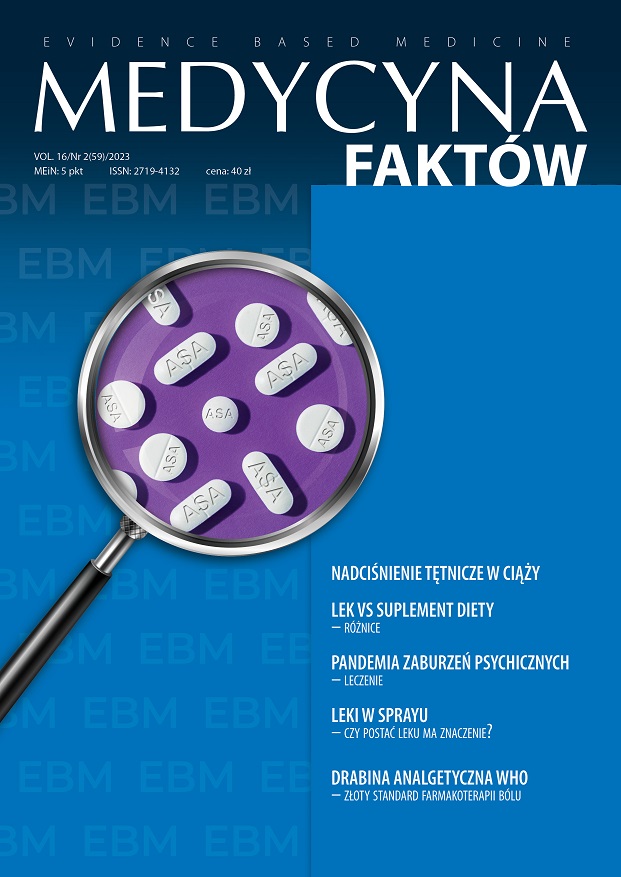Ketoprofen w sprayu o zwiększonej dawce – czy forma i dawka mają znaczenie? Punkt widzenia farmakologa klinicznego Artykuł przeglądowy
##plugins.themes.bootstrap3.article.main##
Abstrakt
Ból zapalny jest konsekwencją obronnej reakcji organizmu na infekcje, uszkodzenie tkanek lub proces autoimmunologiczny. Do bólu ostrego, w którym występuje komponent zapalny, zaliczamy m.in. ból pourazowy. W terapii bólu receptorowego w narządzie ruchu wzrasta znaczenie miejscowych NLPZ. Wynika to zarówno z mechanizmów powstawania bólu zapalnego, jak i profilu farmakokinetycznego topikalnych postaci NLPZ. Jednym z częściej stosowanych leków z grupy NLPZ w postaci topikalnej jest ketoprofen. Podstawowy mechanizm działania ketoprofenu jest związany z hamowaniem aktywności cyklooksygenazy, co w konsekwencji prowadzi do zahamowania syntezy prostanoidów prozapalnych, a w szczególności prostaglandyny E2 (PGE2), która uczestniczy w indukowaniu zapalenia oraz powoduje stymulację bólową. W praktyce leczenia bólu ważna jest zarówno postać zastosowanego leku, jak i zastosowana dawka. W pracy opisano miejsce 10% ketoprofenu w postaci płynu na skórę w terapii bólu i zapalenia.
##plugins.themes.bootstrap3.article.details##
Copyright © by Medical Education. All rights reserved.
Bibliografia
2. Lanas A, Boers M, Nuevo J. Gastrointestinal events in at risk patients starting non-steroidal anti-inflammatory drugs (NSAIDs) for rheumatic diseases: the EVIDENCE study of European routine practice. Ann Rheum Dis. 2015; 74: 675-81.
3. Sarzi-Puttini P, Atzeni F, Lanata L et al. Pain and ketoprofen: what is its role in clinical practice? Reumatismo. 2010; 62: 172-88.
4. Kantor TG. Ketoprofen: a review of its pharmacologic and clinical properties. Pharmacotherapy. 1986; 6: 93-103.
5. Diaz-Reval MI, Ventura-Martinez R, Deciga-Campos M et al. Evidence for a central mechanism of action of S-(+)-ketoprofen. Eur J Pharmacol. 2004; 483: 241-8.
6. Panerai AE, Lanata L, Ferrari M et al. A new ketoprofen lysine salt formulation: 40 mg orodispersible granules. Trends Med. 2012; 12: 159-67.
7. Sarzi-Puttini P, Atzeni F, Lanata L et al. Efficacy of ketoprofen vs. ibuprofen and diclofenac: a systematic review of the literature and meta-analysis. Clin Exp Rheumatol. 2013; 31: 731-8.
8. Mazières B, Rouanet S, Velicy J et al. Topical ketoprofen patch (100 mg) for the treatment of ankle sprain: a randomized, double-blind, placebo- controlled study. Am J Sports Med. 2005; 33(4): 515-23. http://doi.org/10.1177/0363546504268135.
9. Derry S, Conaghan P, Da Silva JA et al. Topical NSAIDs for chronic musculoskeletal pain in adults. Cochrane Database Syst Rev. 2016; 4(4): CD007400. http://doi.org/10.1002/14651858.CD007400.
10. Derry S, Moore RA, Gaskell H et al. Topical NSAIDs for acute musculoskeletal pain in adults. Cochrane Database Syst Rev. 2015; 2015(6): CD007402. http://doi.org/10.1002/14651858.CD007402.
11. Mazières B, Rouanet S, Guillon Y et al. Topical ketoprofen patch in the treatment of tendinitis: a randomized, double blind, placebo controlled study. Rheumatol. 2005; 32(8): 1563-70.
